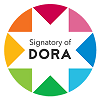Orthopantomographic analysis in determining the recurrent position of third molars
DOI:
https://doi.org/10.37135/ee.04.08.02Keywords:
Molar, Third, Radiography, Panoramic, ClassificationAbstract
Objective: to characterize the recurrent positions in third molars through the orthopantomographic analysis in patients of the Specialized Center in Dentistry "Dr. Mario Cerda e Hijos” in the city of Riobamba-Ecuador during the period 2015-2018. Material and Methods: an observational, descriptive, and cross-sectional study was carried out, in which orthopantomographies of patients were analyzed in this research. The studied population was made up of 172 radiographs, the position of 688 third molars was analyzed in patients aged between 15 to 50 years. Considering the technique, the data collected was the measurement using the negatoscope and the millimeter ruler, which were grouped according to the Winter and Pell and Gregory classifications. Results: 688 third molars were analyzed, the 48.1% was observed in vertical position, followed by the mesioangular position with 31.2%; class II with 43.3%, class I in 31.8% and class III with 18.8%; level B with 35.6%, level C with 34.9% and level A with 23.4%. Conclusion: The vertical position, class I and level C were more frequent in the maxillary third molars; while in the mandible they were the mesioangular position, class II, and level B.
Downloads
References
Stanley J, Major M. Desarrollo y erupción de los dientes. En: Anatomía, fisiología y oclusión dental. 9ª ed. Barcelona: Elsevier; 2010. p. 29-55.
Gay C, Piñera M, Velasco V, Berini L. Cordales incluidos, Patología clínica y tratamiento del tercer molar incluido. En: Tratado de cirugía bucal. Madrid: Ergon; 2005. p. 355-385.
Mouth Healthy [Internet]. Estados Unidos de América: American Dental Association; 2012 [actualizado 2019; citado 4 septiembre 2019]. Disponible en: https://www.mouthhealthy.org/es-MX/az-topics/e/eruption-charts.
Huaynoca N. Tercer molar retenido, impactado e incluido. Rev Act Clin Med. 2012; 25: 1213-1217.
Armand-Lorié M, Legrá-Silot E, Ramos-de la Cruz M, Matos-Armand F. Terceros molares retenidos. Actualización. Rev Inf Cient [Internet]. 2015 [citado 2019 Nov 5]; 92(4): [aprox. 15 p.]. Disponible en: http://www.revinfcientifica.sld.cu/index.php/ric/article/view/217.
Santosh P. Impacted Mandibular Third Molars: Review of Literature and a Proposal of a Combined Clinical and Radiological Classification. Ann Med Health Sci Res [Internet]. 2015 [citado 2019 Nov 3]; 5(4): 229–234. Disponible en: https://www.ncbi.nlm.nih.gov/pmc/articles/PMC4512113/.
Al-Dajani, Abouonq A, Almohammadi T, Alruwaili M, Alswilem R, Alzoubi I. A cohort study of the Patters and Third molar impaction in Panoramic radiographs in Saudi Population. Open Dent J [Internet]. 2017 [citado 2019 Nov 11]; 11: 648-660. Disponible en: https://www.ncbi.nlm.nih.gov/pmc/articles/PMC5750684/. DOI: 10.2174/1874210601711010648.
Alesia K, Khalil H. Reasons for and patterns relating to the extraction of permanent teeth in a subset of the Saudi population. Clin Cosmet Investig Dent [Internet]. 2013 [citado 2019 Oct 23]; 5: 51-56. Disponible en: https://www.ncbi.nlm.nih.gov/pmc/articles/PMC3753858/. DOI: 10.2147/CCIDE.S49403.
Ji-Youn K, Hyeon-Gun J, Hyun-Chul S, Sun-Jong K, Myung-Rae K. Clinical and pathologic features related to the impacted third molars in patients of different ages: A retrospective study in the Korean population. J Dent Sci [Internet]. 2017 [citado 2019 Oct 23]; 12: 354-359. Disponible en: https://www.ncbi.nlm.nih.gov/pmc/articles/PMC6395358/. DOI: 10.1016/j.jds.2017.01.004.
Ayala-Pérez Y, Carralero-Zaldivar Ld, Leyva-Ayala Bd. La erupción dentaria y sus factores influyentes. Correo Científico Médico [Internet]. 2018 [citado 2019 Oct 15]; 22(4): [aprox. 0 p.]. Disponible en: http://www.revcocmed.sld.cu/index.php/cocmed/article/view/2931.
Burgos-Reyes G, Morales-Moreira E, Rodríguez-Martín O, Aragón-Abreu J, Sánchez-Ruiz M. Evaluación de algunos factores predictivos de dificultad en la extracción de los terceros molares inferiores retenidos. MediCiego [Internet]. 2017 [citado 2019 Oct 12]; 23(1): [aprox. 7 p.]. Disponible en: http://www.revmediciego.sld.cu/index.php/mediciego/article/view/613.
Gonzales S, Simancas Y. Clasificaciones Winter y Pell-Gregory predictoras del trismo postexodoncia de terceros molares inferiores incluidos. Rev Venez Invest Odont IADR. 2017; 5(1): 57-75.
Juodzbalys G, Daugela P. Mandibular third molar impaction: review of literature and a proposal of a classification. J oral Maxillofac Res [Internet]. 2013 [citado 2019 Oct 16]; 4(2): 1–11. Disponible en: https://www.ncbi.nlm.nih.gov/pmc/articles/PMC3886113/. DOI: 10.5037/jomr.2013.4201.
Cedeño B, De la Cruz S, Gómez M, Piedrahita A, Sepúlveda W, Moreno F, Hernández J. Cronología de la erupción dentaria en un grupo de mestizos caucasoides de Cali (Colombia). Rev Estomatol [Internet]. 2017 [citado 2019 Oct 24]; 25(1): 16-22. Disponible en: https://go.gale.com/ps/anonymous?id=GALE%7CA537404491&sid=googleScholar&v=2.1&it=r&linkaccess=abs&issn=01213873&p=IFME&sw=w.
Da Silva C, Iwaki V, Yamashita A, Mitsunari W. Estudio radiográfico de la prevalencia de impactaciones dentarias de terceros molares y sus respectivas posiciones. Acta Odontol Ven [Internet]. 2014 [citado 2019 Sep 28]; 52(2). Disponible en: https://www.actaodontologica.com/ediciones/2014/2/art-7/.
Vargas-Madrid W. Factores predictivos para la valoración de dificultad en la extracción de terceros molares inferiores retenidos usando la escala de Romero Ruíz [Tesis para la obtención del título de Odontólogo]. Quito: Universidad Central del Ecuador; 2018.
González-Espangler L. Características anatomorradiográficas de los terceros molares en adolescentes de la enseñanza preuniversitaria. Rev Cubana Estomatol [Internet]. 2019 [citado 2020 Ene 5]; 56(2): [aprox. 13 p.]. Disponible en: http://www.revestomatologia.sld.cu/index.php/est/article/view/1722.
Llerena G, Arrascue M. Tiempo de cirugía efectiva en la extracción de los terceros molares realizadas por un cirujano oral y maxilofacial con experiencia. Rev Estomatol Herediana [Internet]. 2006 [citado 2019 Dic 3]; 16(1): 40-45. Disponible en: https://revistas.upch.edu.pe/index.php/REH/article/view/1930. https://doi.org/10.20453/reh.v16i1.1930.
Menziletoglu D, Tassoker M, Kubilay-Isik B, Esen A. The assesment of relationship between the angulation of impacted mandibular third molar teeth and the thickness of lingual bone: A prospective clinical study. Med Oral Patol Oral Cir Bucal [Internet]. 2019 [citado 2019 Dic 7]; 24(1): e130-135. Disponible en: https://www.ncbi.nlm.nih.gov/pmc/articles/PMC6344005/. DOI: 10.4317/medoral.22596.
Pacheco-Sánchez MS. Posición de los terceros molares en usuarios adultos jóvenes en la consulta privada odontológica de la ciudad de Loja, durante el periodo 2014-2015 [Tesis para la obtención del título de Odontólogo]. Loja: Universidad Nacional de Loja; 2016.
Lanza E, Da Silveira E, Silveira E, Martins T, Dumont O, Moreira S, Furtado P. Association between mandibular third molar position and the occurrence of pericoronitis: A systematic review and meta-analysis. Archives of Oral Biology [Internet]. 2019 [citado 2019 Dic 13]; 107. Disponible en: https://www.sciencedirect.com/science/article/pii/S0003996919305850#. https://doi.org/10.1016/j.archoralbio.2019.104486.
Sujon MK, Alam MK, Rahman SA. Prevalence of Third Molar Agenesis: Associated Dental Anomalies in Non-Syndromic 5923 Patients. PLoS ONE [Internet]. 2016 [citado 2019 Oct 25]; 11(8). Disponible en: https://www.ncbi.nlm.nih.gov/pmc/articles/PMC5006966/. DOI: 10.1371/journal.pone.0162070.
Avelar C, Vasconcellos C, Raggio R, Faraco I, Marazita M, Arnaudo M, et al. Third molar agenesis as a potential marker for craniofacial deformities. Arch Oral Biol [Internet]. 2018 [citado 2019 Oct 19]; 88: 19-23. Disponible en: https://www.ncbi.nlm.nih.gov/pmc/articles/PMC6034603/. DOI: 10.1016/j.archoralbio.2018.01.010.
Additional Files
Published
Versions
- 2021-03-04 (2)
- 2020-06-15 (1)



















